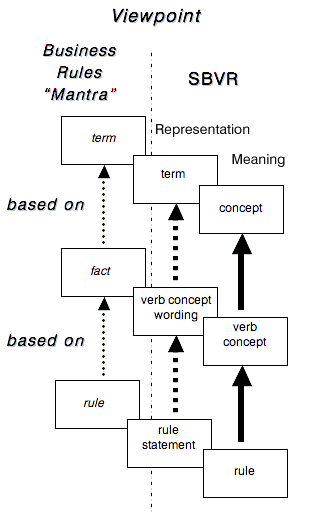The Business Rules Approach
"Rules are a first-class citizen of the requirements world."
"Rules build on facts, and
facts build on concepts as expressed by terms."
Key Notions of the Business Rules Approach
Key notions of the business rules approach are presented succinctly by the BRG's Business Rules Manifesto. An extract from the Manifesto is presented here, to assist those new to the approach in positioning some of the central notions of the Business Rules Approach. This brief extract is followed by a figure that provides an overview of of the way these key notions are reflected in the Semantics of Business Vocabulary and Business Rules (SBVR).
Primary Requirements, Not Secondary. Rules are essential for, and a discrete part of, business models and technology models. Separate From Processes, Not Contained In Them. Rules apply across processes and procedures. There should be one cohesive body of rules, enforced consistently across all relevant areas of business activity. Deliberate Knowledge, Not A By-Product. Rules build on facts, and facts build on concepts as expressed by terms. Terms express business concepts; facts make assertions about these concepts; rules constrain and support these facts. Rules are basic to what the business knows about itself -- that is, to basic business knowledge. Rules need to be nurtured, protected and managed. Declarative, Not Procedural. Rules should be expressed declaratively in natural-language sentences for the business audience. A rule is distinct from any enforcement defined for it. A rule and its enforcement are separate concerns. Well-Formed Expression, Not Ad Hoc. Business rules should be expressed in such a way that they can be validated for correctness by business people. Business rules should be expressed in such a way that they can be verified against each other for consistency. For the Sake of the Business, Not Technology. Rules are about business practice and guidance; therefore, rules are motivated by business goals and objectives and are shaped by various influences. The cost of rule enforcement must be balanced against business risks, and against business opportunities that might otherwise be lost. Of, By and For Business People, Not IT People. Rules should arise from knowledgeable business people. Managing Business Logic, Not Hardware/Software Platforms. Rules, and the ability to change them effectively, are fundamental to improving business adaptability.
The Business Rules Mantra
A core idea of the business rules approach is the following from the Business Rules Manifesto:
"Rules build on facts, and facts build on concepts as expressed by terms. Terms express business concepts; facts make assertions about these concepts; rules constrain and support these facts."
This core idea, originating in the BRG's seminal 1995 white paper, has been called the Business Rules 'mantra'. It is often abbreviated for convenience to simply:
"Rules are based on facts, and facts are based on terms."
The figure below provides an overview of how SBVR supports the 'mantra'. It requires separation of viewpoints as follows:
Business Rule 'Mantra'. An approximation that simplifies explanation for business people and others new to the approach.
Representation (in SBVR terminology). The SBVR notions that classify the words that people use to express their vocabulary + rules.
Meaning (in SBVR terminology). The SBVR notions that classify the underlying meaning of the words that people use in expressing their vocabulary + rules.
